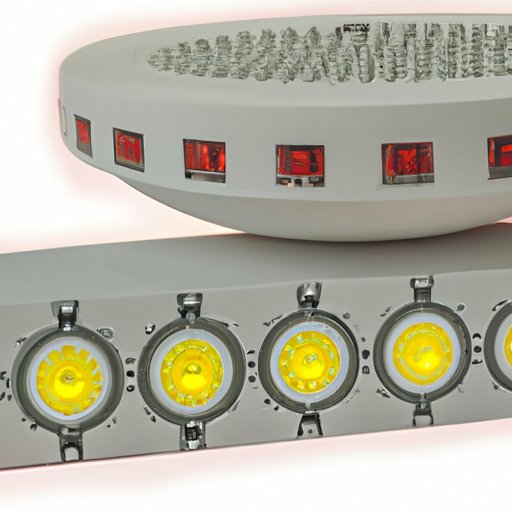Introduction
LED lights (Light Emitting Diodes) are small electronic devices that convert electrical energy into light. They are becoming increasingly popular due to their efficiency and long life span. In this article, we will explore how LED lights work by examining the physics behind the technology, understanding the anatomy of an LED light, exploring the benefits of using LED lighting, and looking at how LEDs are used in a variety of lighting applications.
Exploring the Physics Behind LED Light Technology
LEDs produce light through the process of electroluminescence. This process occurs when electrons move through a semiconductor material, such as gallium arsenide, and release energy in the form of light. The electrons move from the positively charged layer of the semiconductor to the negatively charged layer, releasing energy in the form of photons.

Understanding the Anatomy of an LED Light
An LED light consists of several components. The main component is the diode, which is the semiconductor material mentioned above. It is surrounded by an encapsulant, which protects the diode from external forces. The diode is also connected to two electrodes, which provide an electrical current to the diode so it can produce light. Finally, the LED light has a reflector, which helps to direct the light produced by the diode.
The Benefits of Using LED Lighting
There are many benefits to using LED lighting, including lower power consumption, longer life spans, and greater efficiency. These benefits make LED lighting a great option for both residential and commercial lighting applications.
Lower Power Consumption
LED lights use less energy than traditional incandescent bulbs, making them much more efficient. This means that you can save money on your electric bill by switching to LED lighting.
Long Life Span
LED lights have a much longer life span than other types of light bulbs. This means that you don’t have to replace them as often, saving you time and money in the long run.
Greater Efficiency
LED lights are more efficient than other types of lighting because they convert most of the energy they consume into light rather than heat. This makes them a great choice for lighting applications where efficiency is important.

How LEDs are Used in Lighting Applications
LED lights are used in a variety of lighting applications, including residential, commercial, and automotive lighting. Let’s take a look at each of these applications in more detail.
Residential Lighting
LED lights are becoming increasingly popular for residential lighting applications. They are often used for task lighting, accent lighting, and outdoor lighting. They are also becoming more common for general lighting due to their efficiency and long life span.
Commercial Lighting
LED lights are also widely used in commercial lighting applications. They are often used for security lighting, signage lighting, and landscape lighting. They are also becoming increasingly popular for office and retail lighting due to their efficiency and long life span.
Automotive Lighting
LED lights are also used in automotive lighting applications. They are often used for headlights, taillights, and interior lighting. They are becoming increasingly popular for these applications due to their efficiency and long life span.

An Overview of LED Lighting Design Options
LED lights offer a variety of design options, including RGB color mixing, dimming capabilities, and controlling brightness. Let’s take a look at each of these design options in more detail.
RGB Color Mixing
RGB color mixing allows you to mix different colors of light to create a variety of effects. This is especially useful for creating dynamic lighting effects or special effects for theatrical performances.
Dimming Capabilities
LED lights can be dimmed to adjust the level of light in a space. This is especially useful for creating mood lighting or controlling the brightness of a room.
Controlling Brightness
LED lights can also be used to control the brightness of a space. This is especially useful for adjusting the brightness of a room depending on the time of day or the activity taking place in the room.
Conclusion
LED lights are becoming increasingly popular due to their efficiency and long life span. By exploring the physics behind LED light technology, understanding the anatomy of an LED light, and looking at how LEDs are used in a variety of lighting applications, we can better understand how LED lights work and the benefits they offer. Additionally, LED lights offer a variety of design options, such as RGB color mixing, dimming capabilities, and controlling brightness. All of these features make LED lights a great option for both residential and commercial lighting applications.
(Note: Is this article not meeting your expectations? Do you have knowledge or insights to share? Unlock new opportunities and expand your reach by joining our authors team. Click Registration to join us and share your expertise with our readers.)
